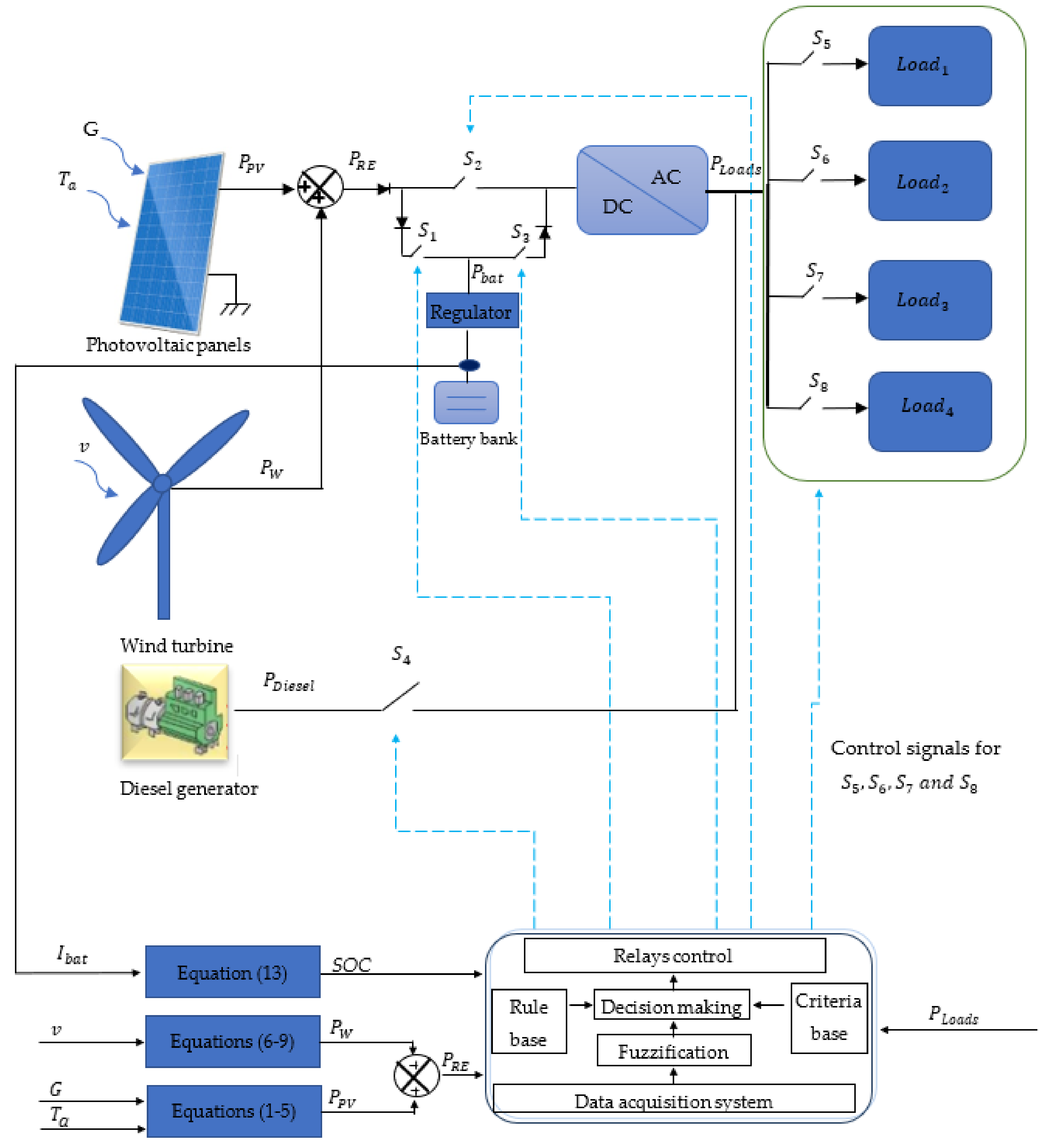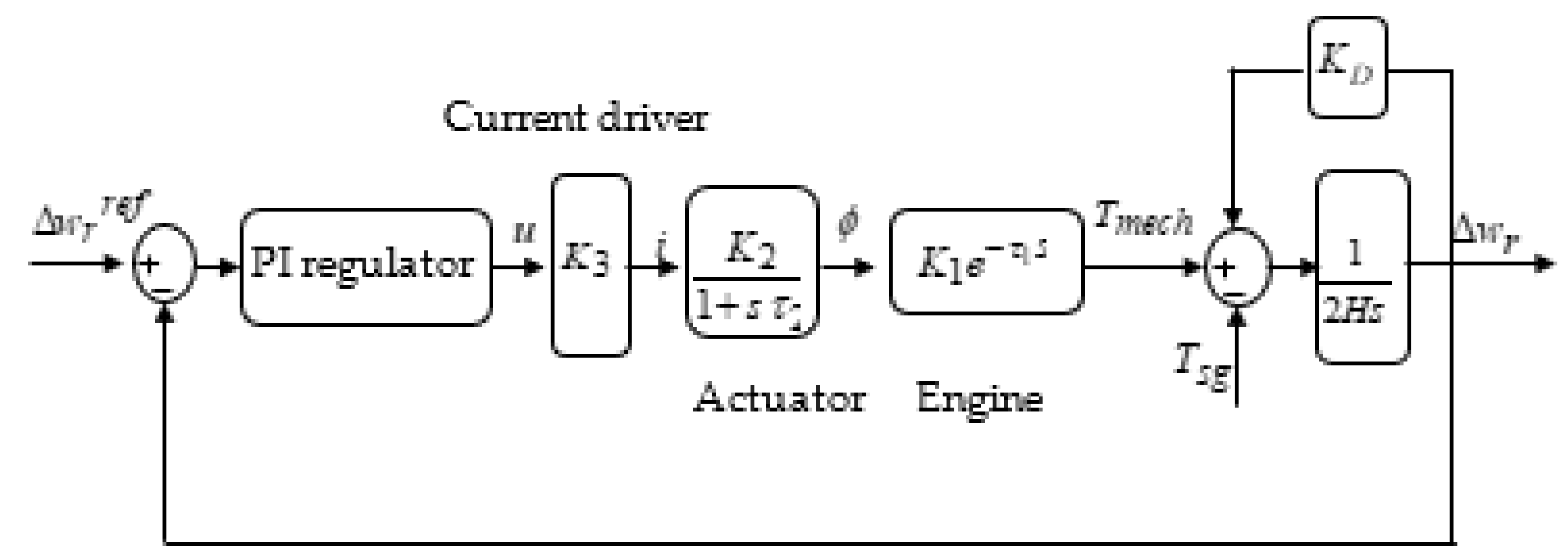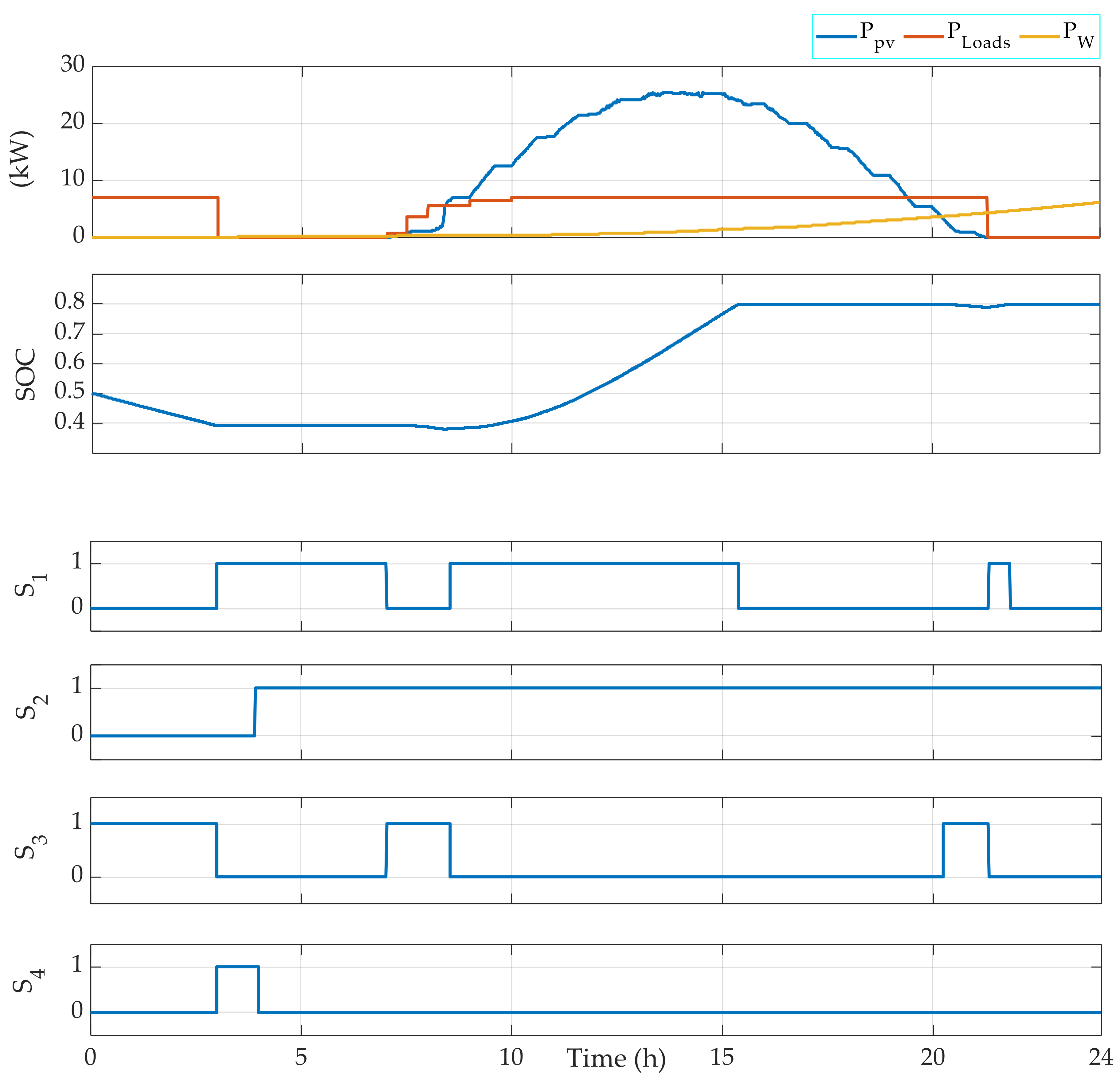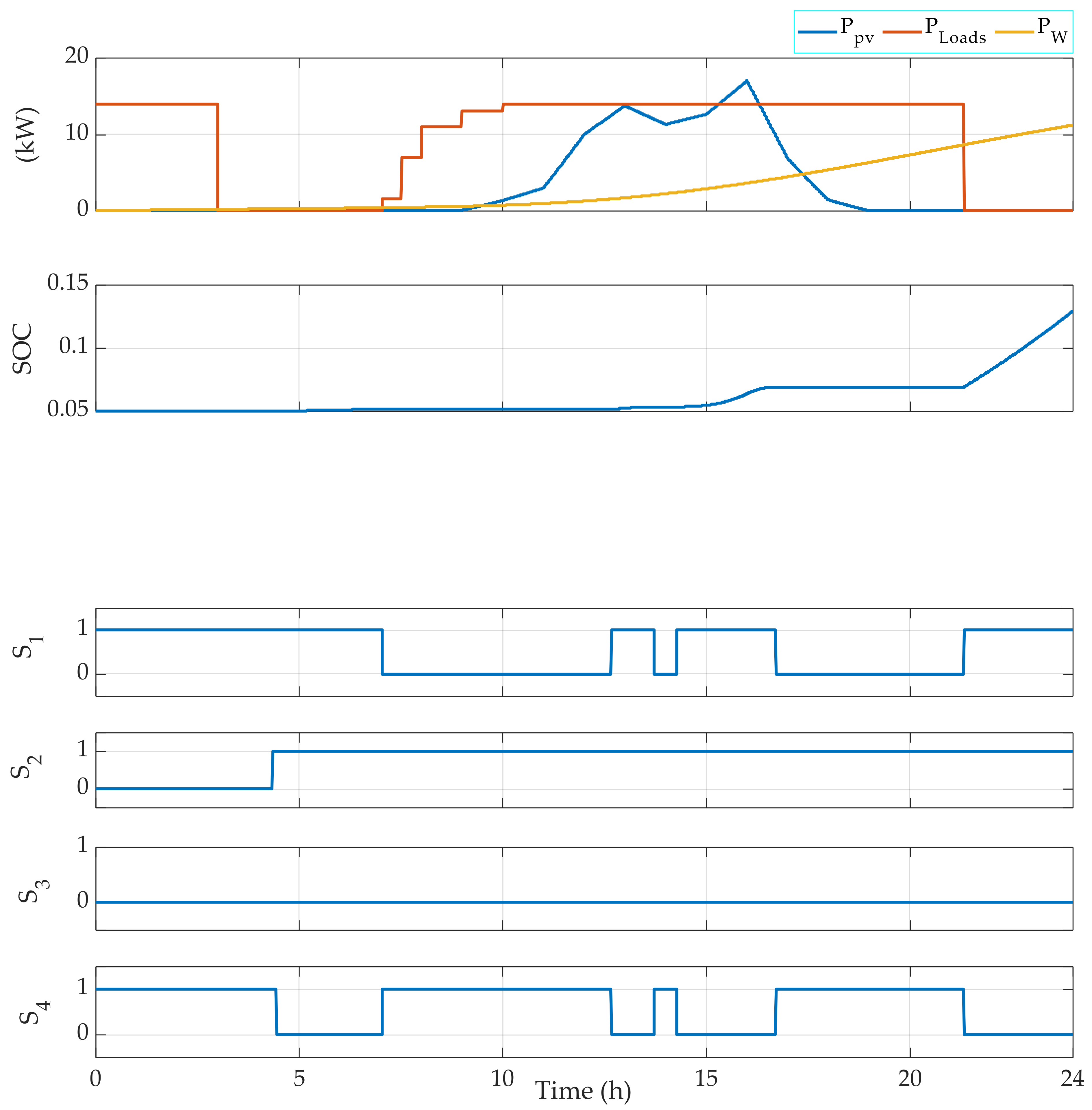Energy Management Strategy for an Autonomous Hybrid Power Plant Destined to Supply Controllable Loads
Abstract
:1. Introduction
- ➢
- The authors apply the fuzzy logic to decide on the switching time of the switches that links the hybrid plant’ components (Figure 1). For this, an EMS is designed and tested using the measured climatic data of Mostoles, (Madrid, Spain), during three typical days of July, March, and December.
- ➢
- The load operation is also deduced using the EMS.
- ➢
- The EMS is applied in a hybrid plant with the objective of maximizing the use of the power generated from the renewable energy components, on the one hand, and minimizing the use of the battery bank and especially the diesel generator, on the other one.
2. Materials and Methods
2.1. System Components Modeling
2.1.1. Photovoltaic Power Generation Model
- : the estimated photovoltaic current (A),
- : the generated photo-current at a given irradiance G (A),
- : the short circuit current for a given temperature (A),
- : the reverse saturation current for a given temperature (A),
- : the reverse saturation current for the reference temperature (A),
2.1.2. Wind Turbine Generation Model
2.1.3. Diesel Generator Model
2.1.4. Battery Bank Model
- : the available energy in the battery bank (Wh),
- : the batteries number,
- : battery’s nominal capacity (Ah),
- : Peukert constant,
- : battery bank nominal voltage (V).
2.1.5. Loads Model
2.2. Fuzzy Management Algorithm (FMA)
2.2.1. Management Strategy
- The load must be supplied with stability. For this:
- The renewable energy sources supply the loads (without the battery bank participation) only when the power demanded by the loads is lower than the power generated by the RE sources.
- The time between switches of the switches is controlled. Consequently, the switching of the switches is minimized.
- The battery bank is used to save the unused RE, which is later used by the loads during the night or when the renewable power generated is less than the power required by the controllable loads.
- To protect the batteries against deep discharges and excessive charges. For this, during the charging or discharging process, the SOC should be maintained between the following limits ( = 10% and = 90%).
- The battery bank can only be charged by the power generated by the renewable sources .
- Deducing the time and identifying which load(s) should be operating, depending on the power demanded.
- Minimizing the switching of the loads.
2.2.2. Switching Modes
- Mode 1: During this mode, only the switch is switched ON. The battery is moderately or almost discharged. Thus, all the renewable power is used to feed the battery.
- Mode 2: The switches and are switched ON. In this case, the RE sources provide the power required by the loads. If the batteries are not fully charged, the excessed RE power is used to charge the battery bank. Otherwise, this energy is not used.
- Mode 3: In this mode, the switches and are switched ON, while is switched OFF. In this mode, the battery bank is moderately or fully charged. Thus, it supplies the loads together with the photovoltaic panels and the wind turbine with the required electrical power. Indeed, it is common to have this mode during the earliest hours of the morning or the latest hours of the afternoon during which the RE power is not sufficient for supply the loads with the required power. Hence, the battery bank provides the loads with the remaining power needed.In this mode,
- Mode 4: This mode is possible during the night. In this mode, only is switched ON. In this case, the battery moderately or fully charged supplies the loads.
- Mode 5: This mode is obtained in the case that the power generated by the RE sources is not sufficient and the battery bank is totally discharged or in the case that there is no power required by the load. Hence, the renewable energy is used to charge the batteries and the loads are supplied by the diesel generator. Therefore, the switches and are switched ON, while the switches and are switched OFFOFF.
- Mode 6: This mode is activated when only the switch is ON, while the rest of the switches are OFF.
2.3. Fuzzy Management Algorithm
2.3.1. The Knowledge Base
- First partition (Renewable power )
- Second partition (State of Charge SOC)
- Third partition (total required loads’ power )
- Fourth partition (Loads’ operation)
- Fifth partition (switches
- ❖
- First case: SOC X = [0, 0.1]: in this interval, charging the battery is preferred to supplying the loads.
- ❖
- Second case: SOC Y = [0.1, 0.8]: in this interval, supplying the loads is preferred to charging the battery bank.
- ❖
- Third case: SOC Z = [0.8, 1]: in this case, the loads are supplied by the RE sources and/or the battery.
2.3.2. Fuzzification
2.3.3. Inference Diagram
2.3.4. Defuzzification
2.4. Algorithm Execution
- Estimation of the RE power generation based on the measured solar radiation, the ambient temperature, and the wind speed.
- Estimation of the demanded power
- Estimation of the SOC based on the measured battery current.
- Fuzzification of the fuzzy inputs.
- Inference diagram performance.
- Defuzzification: Deduction of the fuzzy outputs using the trapezoidal method.
3. Results
4. Discussions
5. Conclusions
Author Contributions
Funding
Institutional Review Board Statement
Informed Consent Statement
Conflicts of Interest
References
- Boujoudar, Y.; Azeroual, M.; Elmoussaoui, H.; Lamhamdi, T. Intelligent control of battery energy storage for microgrid energy management using ANN. Int. J. Electr. Comput. Eng. 2021, 11, 2088–8708. [Google Scholar] [CrossRef]
- Ashenov, N.; Myrzaliyeva, M.; Mussakhanova, M.; Nunna, H.K. Dynamic Cloud and ANN based Home Energy Management System for End-Users with Smart-Plugs and PV Generation. In Proceedings of the 2021 IEEE Texas Power and Energy Conference (TPEC), College Station, TX, USA, 2–5 February 2021; pp. 1–6. [Google Scholar]
- Abdolrasol, M.G.; Mohamed, R.; Hannan, M.A.; Al-Shetwi, A.Q.; Mansor, M.; Blaabjerg, F. Artificial Neural Network Based Particle Swarm Optimization for Microgrid Optimal Energy Scheduling. IEEE Trans. Power Electron. 2021, 36, 12151–12157. [Google Scholar] [CrossRef]
- Mansouri, S.A.; Ahmarinejad, A.; Nematbakhsh, E.; Javadi, M.S.; Jordehi, A.R.; Catalão, J.P. Energy management in microgrids including smart homes: A multi-objective approach. Sustain. Cities Soc. 2021, 69, 102852. [Google Scholar] [CrossRef]
- Zandrazavi, S.F.; Guzman, C.P.; Pozos, A.T.; Quiros-Tortos, J.; Franco, J.F. Stochastic multi-objective optimal energy management of grid-connected unbalanced microgrids with renewable energy generation and plug-in electric vehicles. Energy 2021, 241, 122884. [Google Scholar] [CrossRef]
- Yin, N.; Abbassi, R.; Jerbi, H.; Rezvani, A.; Müller, M. A day-ahead joint energy management and battery sizing framework based on θ-modified krill herd algorithm for a renewable energy-integrated microgrid. J. Clean. Prod. 2021, 282, 124435. [Google Scholar] [CrossRef]
- Berrueta, A.; Heck, M.; Jantsch, M.; Ursúa, A.; Sanchis, P. Combined dynamic programming and region-elimination technique algorithm for optimal sizing and management of lithium-ion batteries for photovoltaic plants. Appl. Energy 2018, 228, 1–11. [Google Scholar] [CrossRef]
- Ammari, C.; Belatrache, D.; Touhami, B.; Makhloufi, S. Sizing, optimization, control, and energy management of hybrid renewable energy system—A review. Energy Built Environ. 2021. [Google Scholar] [CrossRef]
- Jangi, R. Neuro-Fuzzy Modeling: Architecture. Analysis and Application. Ph.D. Thesis, University of California, Berkeley, CA, USA, 1992. [Google Scholar]
- Van Leekwijck, W.; Kerre, E.E. Defuzzification: Criteria and classification. Fuzzy Sets Syst. 1999, 108, 159–178. [Google Scholar] [CrossRef]
- Dawoud, S.M.; Xiangning, L.; Okba, M.I. Hybrid renewable microgrid optimization techniques. A review. Renew. Sustain. Energy Rev. 2018, 82, 2039–2052. [Google Scholar]
- Laughton, M.A.; Say, M.G. Electrical Engineer’s Reference Book; Elsevier: Amsterdam, The Netherlands, 2013. [Google Scholar]
- Althubaiti, M.; Bernard, M.; Musilek, P. Fuzzy logic controller for hybrid renewable energy system with multiple types of storage. In Proceedings of the 2017 IEEE 30th Canadian Conference on Electrical and Computer Engineering (CCECE), Windsor, ON, Canada, 30 April 2017; pp. 1–6. [Google Scholar]
- Courtecuisse, V.; Sprooten, J.; Robyns, B.; Petit, M.; Francois, B.; Deuse, J. A methodology to design a fuzzy logic-based supervision of Hybrid Renewable Energy Systems. Math. Comput. Simul. 2010, 81, 208–224. [Google Scholar] [CrossRef]
- Derrouazin, A.; Aillerie, M.; Mekkakia-Maaza, N.; Charles, J.P. Multi input-output fuzzy logic smart controller for a residential hybrid solar-wind-storage energy system. Energy Convers. Manag. 2017, 148, 238–250. [Google Scholar] [CrossRef]
- Available online: www.pvsyst.com (accessed on 20 November 2021).
- Ouramdane, O.; Elbouchikhi, E.; Amirat, Y.; Gooya, E.S. Optimal Sizing and Energy Management of Microgrids with Vehicle-to-Grid Technology: A Critical Review and Future Trends. Energies 2021, 14, 4166. [Google Scholar] [CrossRef]
- Available online: www.homerenergy.com (accessed on 20 November 2021).
- Yahyaoui, I.; Tadeo, F.; Segatto, M.V. Energy and water management for drip-irrigation of tomatoes in a semi-arid district. Agric. Water Manag. 2017, 183, 4–15. [Google Scholar] [CrossRef]
- Yahyaoui, I.; Ghraizi, R.; Tadeo, F. Optimization of Operational Costs of renewable energy microgrids in Mediterranean climate. In Proceedings of the International Renewable Energy Conference (IREC), Hammamet, Tunisia, 22–24 March 2016. [Google Scholar]
- Li, J.; Li, R.; Jia, Y.; Zhang, Z. Prediction of I–V Characteristic Curve for Photovoltaic Modules Based on Convolutional Neural Network. Sensors 2021, 20, 2119. [Google Scholar] [CrossRef] [Green Version]
- Wang, S.; Luo, H.; Ge, Y.; Liu, S. A new approach for modeling photovoltaic modules based on difference equation. Renew. Energy 2021, 168, 85–96. [Google Scholar] [CrossRef]
- Tao, Y.; Bai, J.; Pachauri, R.K.; Sharma, A. Parameter extraction of photovoltaic modules using a heuristic iterative algorithm. Energy Convers. Manag. 2020, 224, 113386. [Google Scholar] [CrossRef]
- Kumar, G.B. Optimal power point tracking of solar and wind energy in a hybrid wind solar energy system. Int. J. Energy Environ. Eng. 2021, 1–27. [Google Scholar] [CrossRef]
- Wang, J.; Bo, D.; Miao, Q.; Li, Z.; Wu, X.; Lv, D. Maximum power point tracking control for a doubly fed induction generator wind energy conversion system based on multivariable adaptive super-twisting approach. Int. J. Electr. Power Energy Syst. 2021, 124, 106347. [Google Scholar] [CrossRef]
- Salazar, J.; Tadeo, F.; de Prada, C.; Palacin, L. Modelling and Simulation of Auxiliary Energy Systems for OFF-grid Renewable Energy Installation. In Proceedings of the International Renewable Energy Congress, Hammamet, Tunisia, 20–22 December 2011. [Google Scholar]
- Salazar, J.; Tadeo, F.; Prada, C. Modelling of Diesel Generator Sets That Assist OFF-Grid Renewable Energy Micro-grids. Renew. Energy Sustain. Dev. 2015, 1, 72–80. [Google Scholar] [CrossRef]
- Boulmrharj, S.; Ouladsine, R.; NaitMalek, Y.; Bakhouya, M.; Zine-dine, K.; Khaidar, M.; Siniti, M. Online battery state-of-charge estimation methods in micro-grid systems. J. Energy Storage 2020, 30, 101518. [Google Scholar] [CrossRef]
- Zhang, M.; Fan, X. Review on the state of charge estimation methods for electric vehicle battery. World Electr. Veh. J. 2020, 11, 23. [Google Scholar] [CrossRef] [Green Version]
- Sreedhar, R.; Karunanithi, K. Design, simulation analysis of universal battery management system for EV applications. Mater. Today Proc. 2021. [Google Scholar] [CrossRef]
- Novák, V.; Perfilieva, I.; Mockor, J. Mathematical Principles of Fuzzy Logic; Springer Science & Business Media: Berlin/Heidelberg, Germany, 2012; Volume 517. [Google Scholar]
- Anthony, M.; Prasad, V.; Kannadasan, R.; Mekhilef, S.; Alsharif, M.H.; Kim, M.K.; Jahid, A.; Aly, A.A. Autonomous fuzzy controller design for the utilization of hybrid PV-wind energy resources in demand side management environment. Electronics 2021, 10, 1618. [Google Scholar] [CrossRef]
- Aryanfar, A.; Gholami, A.; Pourgholi, M.; Shahroozi, S.; Zandi, M.; Khosravi, A. Multi-criteria photovoltaic potential assessment using fuzzy logic in decision-making: A case study of Iran. Sustain. Energy Technol. Assess. 2020, 42, 100877. [Google Scholar] [CrossRef]
- Behera, M.P.; Ray, P.K. Reactive power and harmonic compensation in a grid-connected photovoltaic system using fuzzy logic controller. Int. J. Emerg. Electr. Power Syst. 2021, 22, 161–175. [Google Scholar] [CrossRef]
- Ilyas, A.; Khan, M.R.; Ayyub, M. FPGA based real-time implementation of fuzzy logic controller for maximum power point tracking of solar photovoltaic system. Optik 2021, 213, 164668. [Google Scholar] [CrossRef]
- Bakkar, M.; Aboelhassan, A.; Abdelgeliel, M.; Galea, M. PV Systems Control Using Fuzzy Logic Controller Employing Dynamic Safety Margin under Normal and Partial Shading Conditions. Energies 2021, 14, 841. [Google Scholar] [CrossRef]
- Sutikno, T.; Subrata, A.C.; Elkhateb, A. Evaluation of Fuzzy Membership Function Effects for Maximum Power Point Tracking Technique of Photovoltaic System. IEEE Access 2021, 9, 109157–109165. [Google Scholar] [CrossRef]
- Ali, M.N.; Mahmoud, K.; Lehtonen, M.; Darwish, M.M. Promising MPPT Methods Combining Metaheuristic, Fuzzy-Logic and ANN Techniques for Grid-Connected Photovoltaic. Sensors 2021, 21, 1244. [Google Scholar] [CrossRef]









Publisher’s Note: MDPI stays neutral with regard to jurisdictional claims in published maps and institutional affiliations. |
© 2022 by the authors. Licensee MDPI, Basel, Switzerland. This article is an open access article distributed under the terms and conditions of the Creative Commons Attribution (CC BY) license (https://creativecommons.org/licenses/by/4.0/).
Share and Cite
Yahyaoui, I.; de la Peña, N.V. Energy Management Strategy for an Autonomous Hybrid Power Plant Destined to Supply Controllable Loads. Sensors 2022, 22, 357. https://doi.org/10.3390/s22010357
Yahyaoui I, de la Peña NV. Energy Management Strategy for an Autonomous Hybrid Power Plant Destined to Supply Controllable Loads. Sensors. 2022; 22(1):357. https://doi.org/10.3390/s22010357
Chicago/Turabian StyleYahyaoui, Imene, and Natalia Vidal de la Peña. 2022. "Energy Management Strategy for an Autonomous Hybrid Power Plant Destined to Supply Controllable Loads" Sensors 22, no. 1: 357. https://doi.org/10.3390/s22010357
APA StyleYahyaoui, I., & de la Peña, N. V. (2022). Energy Management Strategy for an Autonomous Hybrid Power Plant Destined to Supply Controllable Loads. Sensors, 22(1), 357. https://doi.org/10.3390/s22010357





